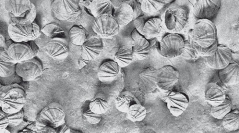

 Geodiversitas
35 (3) - Pages 607-628
Geodiversitas
35 (3) - Pages 607-628The present study relates to the calcareous beds with accumulations of the large pectinid Gigantopecten restitutensis (Fontannes, 1884) in the Lower Miocene of the Apt Basin (Vaucluse). Analysis of the observed thanatocœnoses shows that G. restitutensis predominates in the bioclastic limestones of the Baquis quarries. On the contrary, the sea urchin Tripneustes planus (Agassiz, 1840) predominates in the Soubeyran quarry. These observations led to the hypothesis that these clusters of well-preserved fossils could result of obrution phenomena originated by earthquakes and increasing instability of sedimentary slopes generated by the uplift of the Luberon Mountain during the Upper Burdigalian.
Pectinidae, Lower Miocene, Upper Burdigalian, Apt Basin, Luberon, tectonics, earthquakes, tsunamites, obrution